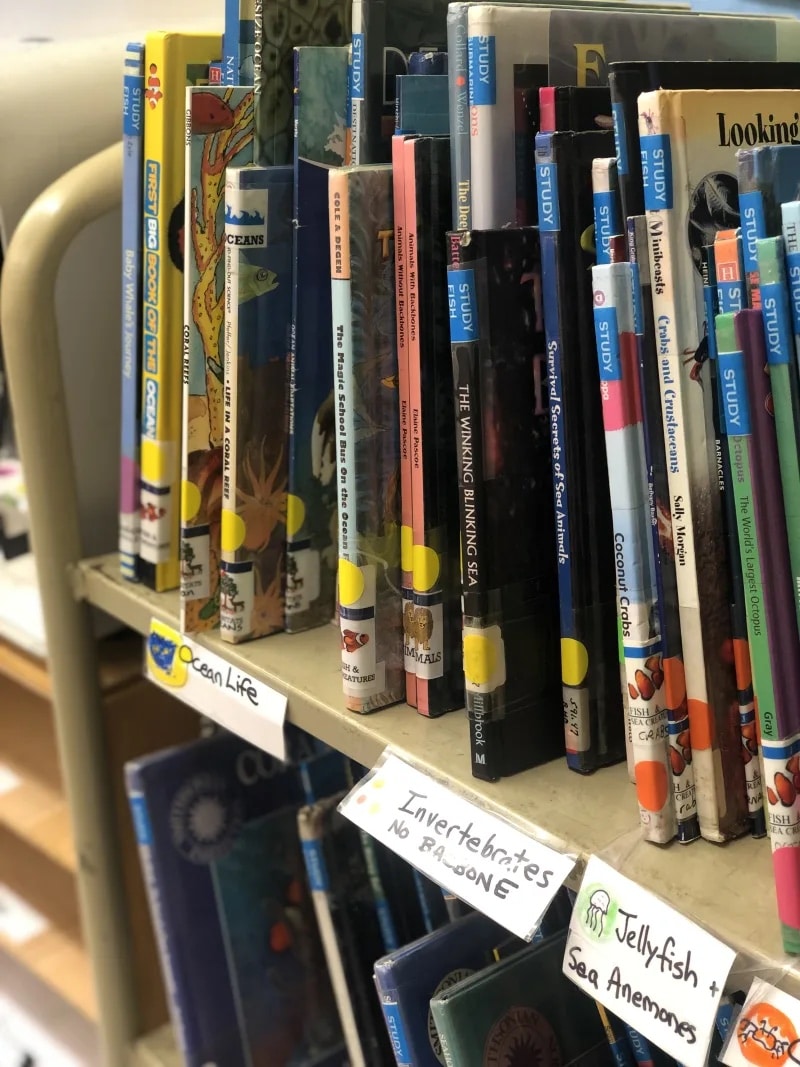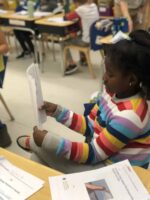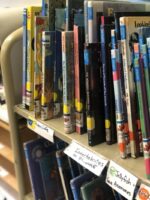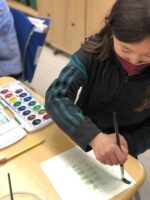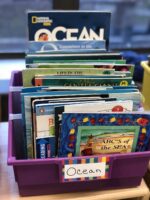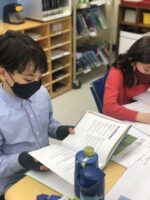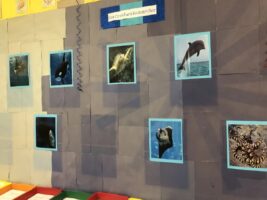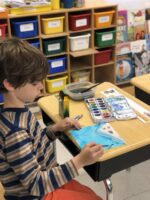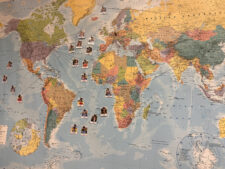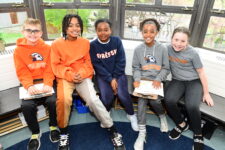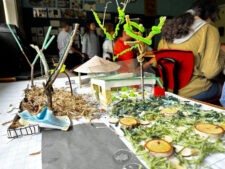It’s a particularly gloomy Thursday in the Bronx, but you wouldn’t know it as you walk through the door of Monique Astengo-Rosen’s 2nd Grade classroom at Fieldston Lower. 2A buzzes with excitement as Astengo-Rosen’s co-teacher Kevin Ortiz Pena hangs up colorful photos of different sea creatures on the wall.
Within seconds of entering the classroom, students begin to rattle off fun fact after fun fact while pointing to a photo of their sea creature with exuberance and pride.
“Did you know that a mimic octopus has a beak like a bird? It uses its beak to remove the shells from the crabs, mussels, and clams that it eats,” George B. ’32 exclaims.
Another student, Kelsey C. ’32 chimes in: “My sea creature is the bottlenose dolphin. Did you know that a baby dolphin is called a calf?”
“I chose the orca! Did you know that orcas basically wear coats to protect themselves from the stingers of manta rays?” adds Theo P. ’32.
The sea creature research project has become an elemental and much-anticipated unit within the 2nd Grade curriculum. There are a few different phases of the project that are completed over the course of several weeks. There is a research phase during which students compile important fun facts about their sea creature, a writing phase where they construct a narrative “book” from the perspective of their sea creature, and finally, an artistic phase where they construct “Who Am I” tri-fold booklets. Although each class follows a similar structure, each teacher on the 2nd Grade team gives the project their own unique twist.
According to Astengo-Rosen, students can choose to study any sea creature that interests them — there’s no list given. Many students arrive in 2nd Grade with a sea creature that they are interested in researching already in mind. Those who are unsure are provided with books and are able to watch videos and documentaries to aid their final decision. Prior to the pandemic, the 2nd Grade would also visit the Maritime Aquarium in Norwalk, Connecticut, to further expose them to different sea creatures.
In the first phase of the project — in collaboration with the Fieldston Lower librarians — the 2nd Grade team introduces students to the research process. After students select their sea creatures, the librarians compile a list of research materials for the students to use. Fieldston Lower Librarian Joan Arrowsmith explains that she and her team assemble a book cart that is made available to students in the classroom. The sea creature book cart — which has been conceptualized and developed over the years — is organized so that students are able to locate information about their sea creatures as independently as possible. Instead of handing the students a pile of books about their selected sea creatures, they are encouraged to seek out books based on the vocabulary terms they learn in Science class. Students are encouraged to ask themselves important questions: Is my sea creature vertebrate or invertebrate? Is my creature a bony or cartilaginous fish?
Because there aren’t limits on which sea creature students can choose, the library team often has to come up with creative ways to provide source materials for students.
For instance, If the librarians cannot find an appropriate grade-level book covering the goby fish or the olive ridley sea turtle — to name a few of the more elusive choices — they will put together a makeshift book compiled of online research for students to use.
“It’s really all about validating students’ curiosity,” explains Arrowsmith.
Much like the comprehensive bird study that students participated in during 1st Grade, the sea creature research project covers science, social studies, reading, and writing. Students build upon the skills they accumulated in prior years to learn about informational writing, vocabulary building, capitalization, punctuation, sentence writing, and spelling.
After reading through several resources and compiling all the necessary information in their research organizer, students then begin the writing portion of the project, during which they construct a narrative for their sea creature.
“My sea creature is the manta ray,” writes Jamie R. ’32. “It is black and white, weighs around 3,000 pounds, and is about 15 to 20 feet wide.”
One student, Abby W. ’32, is so excited to explain what she knows about her sea creature, the pink dolphin, that she recites nearly everything from her research booklet without referring to it once. “Wow!” she exclaims. “I think I just explained my entire narrative out loud.”
Despite the many creative components of this project, Astengo-Rosen explains that the students are typically most proud of their narrative booklets because of the sheer effort and time that they’ve devoted to research.
“This project is definitely not one where I am the teacher,” 2nd Grade teacher Melanie Corcino adds. “Students become the teacher and I become the student. I openly admit that my students are more knowledgeable than me within this project: random facts, an array of sea creature awareness, and connected ideas and thoughts from all the discovered content are impressive.”
The 2nd Graders recently wrapped up the research-heavy portion of the project and have moved on to more artistic tasks. 2A is currently working on “Who Am I” tri-fold booklets, which will soon be on display in the hallway outside of their classroom. These booklets contain three images of their sea creatures — one extreme close-up, one medium shot, and one full-length shot — constructed by the students entirely on their own. The idea is that the reader of the tri-fold booklet will have to guess the sea creature based on artwork and written clues. The final page of the booklet will open to reveal the sea creature both in the full-length shot painting and via an acrostic poem.
“It’s hard to pick a favorite part of the project because the students get so very excited about every aspect,” says Astengo-Rosen.
Each year, the 2nd Grade team, including Astengo-Rosen, Corcino, and Sydney Beres ’14, continue to develop the project.
“The existing core curriculum included each child choosing a sea creature to study and learning about its unique habitats. However, over the course of the 9 years I’ve been working with 2nd Graders, I’ve been fortunate enough to be given the time and space to develop additional related curricula such as the study of the ocean floor, ocean zones, the water cycle, and submersibles,” Astengo-Rosen describes.
In alignment with ECFS’s ethical values, the 2nd Grade educators also ensure that students understand the impact of climate change and other environmental factors on the life cycle of our planet’s ocean life.
“We absolutely add an environmental aspect to this project. We discuss two ideas in great depth: endangered sea creatures and ocean pollution,” Corcino says. More specifically, students learn about the dangers of plastics and the importance of keeping harmful items out of the environment and — as much as possible — to use alternative resources.
One student, Quinn C. ’32, even went so far as to offer possible solutions when she explained that four out of seven species of sea turtles are endangered: “Even if it isn’t yours, if you see any trash on the beach, you should really find a safe way to pick it up and throw it away. Trash in the ocean can harm sea turtles and other fish nearby,” she says.
Students understand that many species are vulnerable to extinction due to human impact. “We explore these topics because, in order to reverse the damage, we need to learn to care about our environment,” Corcino adds. “Activism is a concept we weave through all layers of learning. This unit is no exception.”
Later this spring, the project will culminate with the annual “Sea Creature Museum.” Astengo-Rosen’s class plans to recreate the ocean floor using painted clay. Students will learn about and label various parts, including the continental slope, abyssal plains, guyots, and trenches. Additionally, students will build a large, cardboard model of a submarine in the classroom. When families are invited to visit the museum at the end of the year, the submarine will be on display, and students will work together to conduct three different science experiments to demonstrate their knowledge.
The students are incredibly excited to share their final project with families. “I think it is powerful for students to understand and recognize the value in sharing knowledge,” explains Corcino.
Jamie R. ’32, can’t seem to contain his excitement and proclaims, “my mom is a historian. I can’t wait for her to see how much I’ve learned!”
